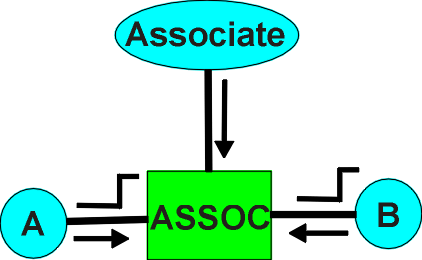

The format of the ASSOCIATE function is:
ASSOCIATE(A@, B@, C@, D@)
The ASSOCIATE function is used to associate or bind several events together. It has a
control pin, Pin 1, which determines which mode it is in.
If the control pin is False, the ASSOCIATE is passive - that is, it will update its internal table based on the states of its connections, but do nothing else. Association is based on the connections having changed within a time step. Saving of the association occurs when data from a new time step arrives.
If the control pin is True, the ASSOCIATE is active - that is, it will put out Bayesian values on its connections, values which are estimates of the states of its connections, based on an internal table. If no incoming data is present at its connections, it will evaluate the likely states on its connections and put out those values. If data becomes available on one or more of its inputs, that will be used to control access to its internal table. Values near 0.5 are not transmitted, so transmission through several ASSOCIATE operators will fade away as the probability approaches 0.5.
The function is either inserted textually, or built as a result of simultaneous activation.
The operator is currently limited to a maximum of six connections, in addition to its control pin.